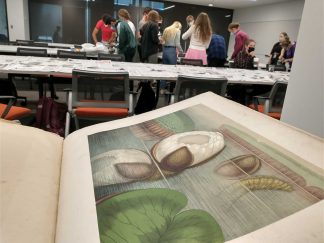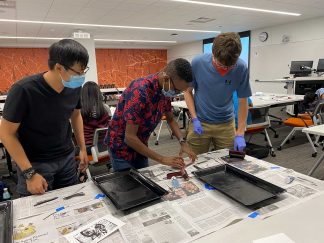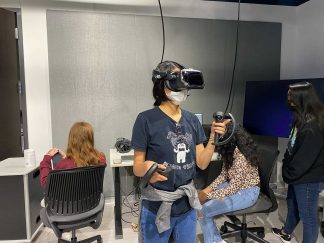By Allison Campbell-Jensen
University Libraries’ staff are among those leading NEXUS One experiences this semester for small groups composed of first-year honors students. In the Wangensteen Historical Library of Biology and Medicine, Curator Lois Hendrickson and Assistant Curator Emily Beck have introduced two sections of 15 first-year honors students each to activities. But their most important contribution may be creating a space for community to develop.
“It’s a place to ask those most basic questions,” Hendrickson says. “But it’s also a way to make some connections, to find other students who are honors students, to make some friends that they might see over and over again.”
The sections meet eight times over the semester with their leaders.
From the Libraries, Tiffany Carlson, Kat Nelsen, Deborah Ultan, and Kate Peterson also are leading NEXUS sections this semester. “The most important result of the NEXUS experience is gaining a greater knowledge of campus and the resources and opportunities available, and to meet new people while doing it,” says Carlson, who is Information Services and Technical Support Specialist in Walter Library.
Meeting with Carlson and his group in the Toaster Breakerspace in Walter, student Brandon Wu said: “I think it’s really neat. I’ve never 3D printed something before. … It’s a really good experience to be introduced to all these resources.”
Libraries’ staff special roles

Wangensteen’s collection of historical materials provided models for NEXUS students creating terrariums.
“Librarians are often the most broadly interested and curious people on campus, and they are used to working with a lot of disciplines and ideas,” says Ian Ringgenberg, Associate Director of Curriculum & Outreach, University Honors Program. “I think that’s a perfect fit for NEXUS One, where one student may be studying ag, the next one sociology, and the next three are engineers. That ability to capture how all those things relate to each other at the University is something that librarians are doing.”
Staff also can model research for students. Peterson brought her section to meet Ryan Bean, Archivist for the Kautz Family YMCA Archives, who introduced them to the Andersen Library exhibit “The YMCA and Relief for War Victims During WWI.” Bean explained to the group of honors students, who ranged in interests from kinesiology to history and economics, the process that he followed to create the exhibit from primary source materials — personal papers and official documents, prisoners’ artworks, and YMCA educational programs.
The process of developing their honors theses, Peterson says, will be similar to the work that Bean had done in creating this exhibit and its focal points; decisions about what to exclude are as important as what to include. After Bean led a tour of the caverns protecting archival materials, a nutrition student stopped to talk with him about possibilities for research and thanked him enthusiastically for pointers on getting in touch with archivists and curators.
Ultan’s Treasures of the Archives group also met with curators from Archives and Special Collections. The students decided to focus on the Kerlan Collection of Children’s Literature, the James Ford Bell Library, the Charles Babbage Institute Archives, and the Sherlock Holmes Collections. One of their sessions was dedicated to how to formulate an archival research question and how to conduct the research.
Intertwined
For four of the eight gatherings, Ringgenberg says, the NEXUS One offers a syllabus to cover on values, on the history of the land-grant university and its relationship to Native land, on research and academic integrity, and reflection. To discover what students might like to do for the other meetings, Hendrickson and Beck surveyed them. Their hands-on activities have included carving blocks for relief printing and creating terrariums, which included illustrative examples from the books in the Wangensteen collection. Hendrickson says they also want the students to recognize that librarians do research with books from their collections.
Darby Ronning, one of the two TAs who team with Beck and Hendrickson who were formerly NEXUS students themselves, is elated to see students get excited about learning “especially in these fun and interesting contexts, with these books and these experiences.” She notes that most of the students in her group are interested in the biological sciences.
“The Wangensteen being a historical library of biology and medicine, sometimes you can see them make connections between history and medicine,” Ronning said. “I hope they can carry that with them throughout their careers.” Ronning, a double major in history and statistics, also is a Wangensteen student employee and a member of the Libraries’ Student Advisory Board.
She notes that when the group gathered before going to the Virtual Reality Studio in the Health Sciences Library, “people legit cheered out loud, they were so excited. … It was cool to see everyone see ways that they could be using VR in their studies and in their lives.”
Hendrickson connects the NEXUS One experiences with student success.
“I’m really interested in helping students navigate their academic journeys through the University, whether that means coming in with a career and a major in mind or finding something that really interests you.” she says. “I think that specifically relates to the goal that President Gabel has, which is meeting students where they are, maximizing their potential and their well-being, checking in with them, learning what they are interested in, and finding out what their needs are.”
It’s gratifying, she adds, to have more time with them than she usually has with undergraduates.
“We did have a student say to us in one of our groups: ‘If there is a prize for the best NEXUS session, you should win,” Hendrickson says. “They are very enthusiastic. They are excited to tell their friends about what they’ve done and introduce them to some of the spaces. It’s not just us influencing these 30 people; these 30 people tell their friends, their roommates, and their family.”
With Libraries’ guides like these, these honors students are moving forward.






